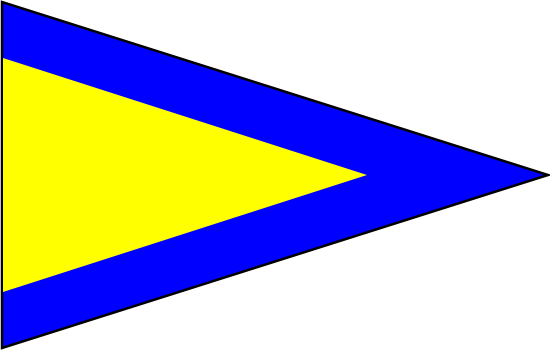by Steve Harris
Several years ago, Sunday afternoons always meant sailboat racing at BLYC for the Harris family. Dad and his crew would race on Tan-Tar-A, I was typically doing race committee work (in the early days without all of the phenomenal helpers that we’ve got today) and Mom would usually come down and watch the races from the porch. I recall a story that she and Betty Snow (mother of Bob Snow on Salad Girl) were watching from the porch one day and overheard a conversation between some other members. Apparently a lady was describing to her friend how the sailboat race worked – or at least how she saw it. She said something to the effect of… “These boats all go out and sail around every which-direction while they fire cannons and put up flags and make a bunch of noise, then all the boats come together at the starting line and then scatter again!” Maybe not a bad description, actually. There’s a lot going on in those minutes before the start and, to the uniformed, the boats do all seem like they’re sailing around aimlessly. Hopefully, they all “come together” on the starting line right at the start signal, and then of course they “scatter” again as they look for their favored tack to make it to the first mark ahead of everyone else.
So… what’s really going on? In this post, I will describe the signals and what they mean, but also what the Race Committee is doing at that time and what (hopefully) the skippers and crews are doing on board to put themselves in the perfect position to start. It’s a bit lengthy, but hopefully complete.
The “Wake-Up” Signal
Typically, about one minute before the starting sequence begins the race committee will sound a series of short horns to alert the fleet that we are getting ready to start a race. This is a courtesy and not required by the rules, but it is commonly done at most races
What is the Race Committee doing?
- If they haven’t already done so, the course to be sailed is posted (required to be posted by the Warning Signal)
- At this time, the Race Committee usually has the starting line set, and maybe the other marks of the course. It’s at this time that the focus turns to the task at hand of getting the race started.
- Everybody assumes their role (flag signaller, timer, etc.) and confirms the boats that are in the starting area.
- The Race Committee is checking in boats to note who is in the starting area and racing today.
What should the Sailors be doing?
- Hopefully, any equipment adjustments have been made and all crew know their roles for the start sequence. If you’re not in the starting area, it’s time to get there.
- Who’s responsibility is it to watch the time?
- Assign someone to watch for the Warning Signal to set their countdown watch so that the crew knows exactly where they are in the sequence. This should be their only job during this minute.
- Who’s looking for wind shifts?
- Who’s keeping an eye out on the other boats and watching for right-of-way situations?
- Who makes the final decisions on the starting plan?
The Warning Signal – 5 minutes to the Start
At the Warning Signal, the Class Flag is raised with one sound.

What exactly the “Class Flag” is varies. At BLYC, we typically use numeral pennants (the one shown above is “3”). Sometimes, it is a plain colored flag, or a flag with the class logo on it. Sailors know which flag is theirs as they are detailed in the Sailing Instructions they all receive.
What is the Race Committee doing?
- In our typical Sunday racing at BLYC, the course is already set. However, if we were starting on the water and had plenty of mark boats, the PRO would be waiting until now to make final decisions on where exactly to put the first mark. Wind is always shifty (especially at Buckeye Lake) so it’s hard to get it perfect, but ideally, that mark is set directly upwind (or at least the average of what directly upwind is)
- The RC verifies that the starting line is set (and not drifting)
- The decision is made whether or not a starting penalty will be used and that the flag signaller has the proper flag for the next signal
What should the Sailors be doing?
- Hopefully the countdown timer was started with the Warning Signal. If not, one minute from now is the last, practical chance to do so. It is now their job to keep everyone on board apprised of how much time is remaining to the start – an announcement about every 30 sec. should suffice for now.
- This is a good time to check the wind and confirm its direction relative to the course.
- Courses are seldom perfectly square to the wind so there is likely going to be a side of the course that is favored (shorter trip to the first mark) and one end of the starting line that is favored.
- Sail to the middle of the starting line and turn the boat head-to-wind. Make a note of the compass direction. If it’s not the same as the compass direction to the mark, one side of the course is favored – that is, close-hauled one side will take you more directly towards the mark. If you’re pointed into the wind yet left of the mark, you will want to spend more time on starboard tack – and vice versa
- Is your boat pointing directly perpendicular to the starting line? Or are you pointing more towards one end or the other? If you are, that is the favored end and – absent of other factors – that’s the end you want to start at.
- Start putting a plan together. Discuss it freely and openly but remember, one person makes the final decision.
- Keep in mind that you may need to change or modify your plan based on the presence of other boats, and the fact that the wind direction may change.
- Who is watching for wind shifts? Are they mere oscillations or is it a “permanent” shift?
- Don’t get stuck in a plan doomed to failure just because its the plan – Keep you head out of the boat!
- Keep in mind that you may need to change or modify your plan based on the presence of other boats, and the fact that the wind direction may change.
The Preparatory Signal – 4 minutes to the Start
At the Preparatory Signal, the Preparatory Flag is raised with one sound.

There are several different flags that can be used for the preparatory signal, depending on whether or not a starting penalty is being employed. Generally, for our Sunday races at BLYC, we use Code Flag “P” (above) which signifies no starting penalties.
What is the Race Committee doing?
- “The longest three minutes in sport”
- It doesn’t seem like there’s much for the Race Committee to do during this time – 3 minutes seems to last forever. But, in reality, there’s a lot to keep track of to ensure a fair start and a fair race.
- It may be three minutes of relative boredom, but it is followed by one minute of insanity, so there’s actually a lot to get ready for…
- Monitor wind direction, speed, and course configuration
- ALWAYS be ready to postpone and try again when conditions improve
- Ensure that the line sighter is ready and in position at least 30 seconds prior to the next signal
- Make sure that the voice recorder is working (seriously – double and triple check)
- Ensure that all flags are ready and in position.
- Postponement (AP), Individual Recall (X), General Recall (1stSub)
- Make sure that everyone knows their job – Things happen fast in the last minute
- Monitor wind direction, speed, and course configuration
What should the Sailors be doing?
It seems like there’s a lot of time, but it will go fast and now’s the time to be perfeecting and modifying your plan. Remember – the goal is to start right on the line, right at the start, and at full speed.
- If there’s time, go take another look at the line
- Did things change since your last check?
- Do you need to adjust your plan?
- Now is when it becomes important to start paying attention to where the other boats in the fleet are. They’re all looking to have the perfect start too.
- You don’t need to overanalyze and completely understand their plan but look at where they are, and what they may have in mind for their start.
- Two objects cannot occupy the same space. Can you start where your wanted to, or do you need to adjust?
- As boats start to “line up” for the start, look for a hole – It’s better to start at speed than in the “ideal” location on the line
- Although you may have the right-of-way over another boat, is “fighting” for that right-of-way productive?
- If it means you start slower, probably not
- If it means that you don’t have clear wind, probably not
- If it means that you’ll potentially end up in other right-of-way situations with different boats after the start (i.e., starting on port tack and getting rolled by all of the starboard tack boats further down the line), probably not.
- Be ready to adjust your plan but be careful not to make hasty decisions either. Your priorities should be (in order)
- AVOID COLLISIONS – make sure you have an “escape plan”
- Boat Speed
- Starting on the line at the start signal if possible
- Favored end of the line/favored side of the course
Removal of the Preparatory Signal – 1 minute to the Start
One minute before the start, the Preparatory Signal (likely code flag “Papa”) is removed with one long sound
What is the Race Committee Doing?
Now is when things get busy…
- Prior to the removal of the preparatory signal, the line sighter has been describing what’s going on the start area – setting up to be able to identify boats that are over early
- The “recall signaller” is ready with the X-ray flag (Individual Recall) and the First Substitute flag (general recall)
- The PRO takes one last look at wind direction and how the fleet is setting up to start
- If it looks like things might go bad…. prepare to postpone the start.
- The timer is counting down the final seconds and ready to start the “elapsed time” counter
- Since most of our racing at BLYC is handicapped, getting the time started right at the start is very important to the fairness of the final results
What should the Sailors be doing?
Hopefully, a plan is in place and being executed well
- The timer is giving regular updates as to the amount of time remaining to the start
- Someone is being the “spotter” to let the skipper know…
- Approximate distance to the starting line
- Locations of other boats
- Do they have right-of-way?
- Do we need to adjust to avoid them?
- Or hail them for our rights?
- REMEMBER – It’s better to be late on the line with speed and clear air than it is to “win” a right-of-way situation with another boat and start at a lower speed
- The Skipper is busy – absorbing lots of information from the crew and ready to make split second decisions…
- SAFETY – Avoid collisions
- It doesn’t matter if you’re “right.” It matters whether you start on time and get to race. If you don’t race, you can’t win
- Ready to execute the escape plan – don’t wait too long!
- SPEED – Starting fast is better than starting first
- If you can’t find a lane that let’s you reach the line at speed, loop around and try again
- Don’t wait too long to make this call – give yourself time to execute the needed tacks and/or gybes and get back up to speed.
- If you can’t find a lane that let’s you reach the line at speed, loop around and try again
- SETUP THE FIRST LEG – So you win the start. Big Deal! What’s next?
- Anticipate where you’re going to be 5 seconds, 10 seconds, 30 seconds after the start.
- Do you need to be prepared to tack away…
- to get clear air
- to avoid other boats
- Do you need to be prepared to tack away…
- Anticipate where you’re going to be 5 seconds, 10 seconds, 30 seconds after the start.
- SAFETY – Avoid collisions
REMOVAL OF THE WARNING SIGNAL – THE START!
At the start, the class flag (warning signal) is lowered with one sound and the race has started
What is the Race Committee doing?
- Hopefully very little, but it seldom works out that way…
- Were there boats over the line (on the course side) ahead of the starting signal?
- Individual Recall (if boats can be identified)
- X-ray flag with one sound

- Typically, the RC will hail the numbers of the OCS boats either verbally or on the VHF
- Someone will be assigned to watch to see if they re-start properly
- General Recall (if there are boats that cannot be identified
- First Substitute flag with two sounds

- The race is abandoned and all boats must return to start again
What should the Sailors be doing?
Hopefully, you got off the line as close to the starting signal as possible but not before, at speed, and you’re sailing away from the fleet!
Now is not the time to relax
Get some good readings on the wind and make your plan for the upwind leg…
- Which tack is best?
- Put your plan together to spend as much time as possible on the favored (lifted) tack
- Where will this put you in relation to other boats?
- Does this create right-of-way issues? ANTICIPATE!
- SAIL, SAIL, SAIL
- If you got a great start, it’s now “yours to lose.”
- Minimizing mistakes is the best (only?) way to keep that lead
- If you got a poor start, how might you improve over other boats on this leg?
- Be careful – don’t take high-risk chances though.
- Hopefully, your competitors will make mistakes and you’ve put yourself in a position to capitalize on that.
- If you got a great start, it’s now “yours to lose.”
- What if you were over early?
- It might sound trite, but you should know if you were over early. Be prepared to correct the error.
- Did the RC signal an individual recall?
- Get yourself below the line as expeditiously as possible and re-start. Again, boat speed matters more than anything else at this point
- Keep in mind, however, that at this moment you have no rights over other boats – you are required to keep clear of them.
- It might sound trite, but you should know if you were over early. Be prepared to correct the error.
FINAL THOUGHTS
Yes, there’s a lot going on in that 5-6 minutes before the start, but it very well may be the most important five minutes of the entire race, both for the sailors and for the race committee.
I hope this helps – for the race committee volunteer, the sailor – veterans and newbies alike – and for the casual observer.
